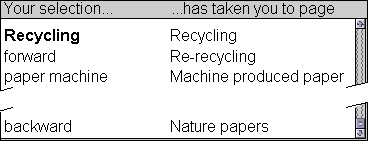
|


5. References
Berry, D.C., & Broadbent, D.E. (1988). Interactive tasks and the implicit-explicit
distinction. British Journal of Psychology, 79, 251-272.
Broadbent, D.E., FitzGerald,
P., & Broadbent, M.H.P. (1986). Implicit and explicit knowledge in the
control of complex systems. British Journal of Psychology, 77, 33-50.
Canter, D., Rivers,
R., & Storrs, G. (1985). Characterising user navigation through complex
data structures. Behaviour & Information Technology, 4, 93-102.
Duffy, T.M., & Jonassen,
D.H. (1992). Constructivism and the technology of instruction: A conversation.
Hillsdale, New Jersey: Lawrence Erlbaum.
Engström, Y. (1990).
When is a tool? Multiple meanings of artifacts in human activity, learning,
working, imagining (pp. 171-195). Helsinki: Orienta-Konsultit Oy.
Fjeld, M., Bichsel,
M., & Rauterberg, M. (1998). BUILD-IT: An intuitive design tool based
on direct object manipulation. In I. Wachsmut & M. Frölich (Eds.), Gesture
and Sign Language in Human-Computer Interaction, Vol. 1371 (pp. 297-308).
Berlin: Springer-Verlag.
Gibson, J.J. (1986).
The ecological approach to visual perception. Hillsdale: Lawrence Erlbaum
Associates.
Guttormsen Schär,
S.G. (1996). The influence of the user-interfaceon solving well- and ill-defined
problems. International
Journal of Human-Computer Studies, 44, 1-18.
Guttormsen Schär,
S.G. (1997b). The history as a cognitive tool for navigation in a hypertext
system. M.J. Smith, G. Salvendy, & R.J. Koubek (Eds.), Vol. 21B (pp. 743-746):
Elsevier.
Guttormsen Schär,
S.G. (1998). Implicit and explicit learning of computerised tasks. The
role of the user-interface and task saliency. Doctoral thesis, University
of Zürich.
Guttormsen Schär,
S.G. (1999a). The effect of continuous vs. discontinuous feedback in a
simulation based learning environment. P.o.E.-M. 1999 (Ed.), Ed-Media
1999, Vol. 11 (pp. 190-194), Seattle, USA: B. Collins R. Oliver.
Guttormsen Schär,
S.G., Schierz, C., Stoll, F., & Krueger, H. (1997a). The effect of the
interface on learning style in a simulation based learning situation.
International Journal of Human-Computer Interaction, 9, 235-253.
Hayes, N.A., & Broadbent,
D.E. (1988). Two modes of learning for interactive tasks. Cognition, 28,
249-276.
Kunkel, K., Bannert,
M., & Fach, P.W. (1995). The influence of design decisions on the usability
of direct manipulation user interfaces. Behaviour & Information Technlogy,
14(2), 93-106.
Maddix, F. (1990).
Human-computer interaction. Theory and practice. New York: Ellis Horwood.
McAleese, R. (1989).
Navigation and browsing in hypertext. In R. McAleese (Ed.), Hypertext
theory into practice (pp. 7-43). Oxford: BSP Intellect books.
Reber, A.R., & Lewis,
S. (1977). Implicit learning: An analysis of the form and structure of
a body of tacit knowledge. Cognition, 5, 333-361.
Reber, A.S. (1976).
Implicit learning of Synthetic Languages: The role of instructional set.
Journal of Experimental Psychology: Human Learning and Memory, 2(1), 88-94.
Reber, A.S. (1989).
Implicit learning and tacit knowledge. Journal of Experimental Psychology:
General, 118, 219-235.
Reber, A.S., & Allen,
R. (1978). Analogic and abstract strategies in synthetic grammar learning:
A functionalist interpretation. Cognition, 6, 189-221.
Reber, A.S., Kassin,
S.M., Lewis, S., & Cantor, G. (1980). On the relationship between implicit
and explicit modes in the learning of a complex rule structure. Journal
of Experimental Psychology: Human Learning and Memory, 6, 492-502.
Sengupta, K., & Te'eni,
D. (1991). Direct manipulation and command language interfaces: a comparison
of user's mental models. In H.J. Bullinger (Ed.), Human Aspects in Computing:
Design and Use for Interactive Systems and Information management. (Advances
in Human Factors/Ergonomics, 18A, pp. 429-434). Amsterdam: Elsevier.
Shneiderman, B. (1987).
Designing the User Interface: Strategies for Effective Human-Computer
Interactions. Reading, MA: Addison-Wesley Publishing Co.
Torres-Chazaro, O.,
Beaton, R., & Deisenroth, M. (1992). Comparison of command language and
direct manipulation interfaces for CNC milling machines. International
Journal of Computer Integrated Manufacturing, 5(2), 107-117.
Trudel, C.-I., & Payne,
S.J. (1995). Reflection and goal management in exploratory learning. International
Journal of Human-Computer Studies, 42, 307-339.
|

|
![]()
![]()





